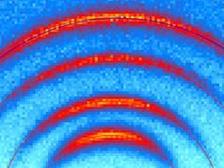Momentum distribution of helium ions from single ionisation (out-take). Credit: Original publication in Phys. Rev. Lett. (2020) (Physics Synopsis (June 2020) )
Light exerts a certain amount of pressure onto a body: sun sails could thus power space probes in the future. However, when photons hit an individual molecule and knock out an electron, the molecule flies toward the light source. In experiments at PETRA III at DESY and at the European Synchrotron Radiation Source ESRF, atomic physicists at Goethe University Frankfurt have now observed this for the first time, confirming a 90 year-old theory. They present their measurements in the journal Physical Review Letters.
As early as the 16th century, the great scholar Johannes Kepler postulated that sunlight exerted a certain pressure, as the tail of the comets he observed consistently pointed away from the sun. In 2010 the Japanese space probe Ikaros used a sun sail for the first time in order to use the power of sunlight to gain a little speed.
Physically and intuitively, the pressure of light or radiation can be explained by the particle characteristic of light: light particles (photons) strike the atoms of a body and transfer a portion of their own momentum (mass times speed) onto that body, which thus becomes faster.
However, when in the 20th century physicists studied this momentum transfer in the laboratory during experiments on photons of certain wavelengths which knocked individual electrons out of atoms, they were met by a surprising phenomenon: the momentum of the ejected electron was greater than that of the photon that struck it. This is actually impossible – since Isaac Newton it has been known that within a system, for every force there must exist an equal but opposite force: the recoil, so to speak. For this reason, the Munich scientist Arnold Sommerfeld concluded in 1930 that the additional momentum of the ejected electron must come from the atom it left. This atom must fly in the opposite direction; in other words, toward the light source. However, this was impossible to measure with the instruments available at that time.
Ninety years later the physicists in the team of doctoral student Sven Grundmann and Professor Reinhard Dörner from the Institute for Nuclear Physics have succeeded for the first time in measuring this effect using the COLTRIMS reaction microscope developed at Goethe University Frankfurt. To do so, they used X-rays at the beamline P04 at PETRA III and at the ESRF in French Grenoble, in order to knock electrons out of helium and nitrogen molecules. They selected conditions that would require only one photon per electron. In the COLTRIMS reaction microscope, they were able to determine the momentum of the ejected electrons and the charged helium and nitrogen atoms – which are called ions – with unprecedented precision.
Professor Reinhard Dörner explains: “We were not only able to measure the ion’s momentum, but also see where it came from – namely, from the recoil of the ejected electron. If photons in these collision experiments have low energy, the photon momentum can be neglected for theoretical modelling. With high photon energies, however, this leads to imprecision. In our experiments, we have now succeeded in determining the energy threshold for when the photon momentum may no longer be neglected. Our experimental breakthrough allows us to now pose many more questions, such as what changes when the energy is distributed between two or more photons.”
(from DESY News / Source: Goethe University Frankfurt)
Reference:
Observation of Photoion Backward Emission in Photoionization of He and N2; Sven Grundmann, Max Kircher, Isabel Vela-Perez, Giammarco Nalin, Daniel Trabert, Nils Anders, Niklas Melzer, Jonas Rist, Andreas Pier, Nico Strenger, Juliane Siebert, Philipp V. Demekhin, Lothar Ph. H. Schmidt, Florian Trinter, Markus S. Schöffler, Till Jahnke, and Reinhard Dörner; Physical Review Letters, 2020; DOI: 10.1103/PhysRevLett.124.233201







